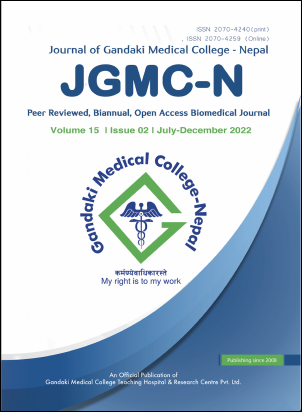Multidrug resistant and extended spectrum β-lactamase producing gram negative bacterial uropathogens among females in a tertiary hospital, Pokhara
DOI:
https://doi.org/10.3126/jgmcn.v15i2.48508Keywords:
Extended spectrum β-lactamase, gram negative isolates, multidrug resistant, urinary tract infectionAbstract
Introduction: Extended spectrum β-lactamase producing gram negative bacilli has emerged and spread worldwide as an important cause of urinary tract infections and indicates a major threat. The study aimed to determine the prevalence of multidrug resistant and extended spectrum beta-lactamase producing gram negative bacterial uropathogens among females in a tertiary level hospital.
Methods: A hospital-based cross-sectional study was conducted in Pokhara Academy of Health Sciences, Pokhara from February to November, 2019. A total number of 301 midstream urine samples were collected and examined using MacConkey agar and blood agar medium. Antimicrobial susceptibility testing was done by Kirby Bauer disk diffusion method on Mueller Hinton agar using Clinical and Laboratory Standards Institute guidelines.
Results: Out of 301 mid-stream urine samples, 99(33%) sample showed significant bacterial growth. Among them, 78(79%) were gram negative bacteria. Escherichia coli were the predominant organism. Multidrug resistant gram negative isolates were 65.4%. Among 78 Gram negative isolates, 31(39.7%) were extended spectrum β-lactamase producers. Among extended spectrum β-lactamase producers, 27(87.1%) were MDR. Highest frequency of extended spectrum β-lactamases production was seen in E. coli, 23(74.2%). Majority of gram negative bacteria showed susceptibility toward colistin and nitrofurantoin. Ampicillin was found to be highly resistant towards gram negative uropathogen.
Conclusions: This study found that higher proportion of multi-drug resistants were among gram negative isolates and further more among extended spectrum β-lactamase producing gram negative isolates. Thus, there is urgent need to address the issue of antimicrobial resistant and promote rational use of the antibiotics in our region.
Downloads
Downloads
Published
How to Cite
Issue
Section
License
Copyright (c) 2022 Raju Pandey, Samjhana Bhattarai, Binita Subedi, Rajan Paudel, Bipin Chapagain, Suresh Jaiswal, Bishnu Raj Tiwari

This work is licensed under a Creative Commons Attribution-NonCommercial 4.0 International License.
This license allows reusers to distribute, remix, adapt, and build upon the material in any medium or format for noncommercial purposes only, and only so long as attribution is given to the creator.




